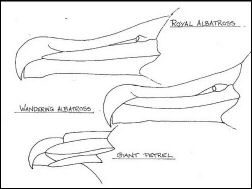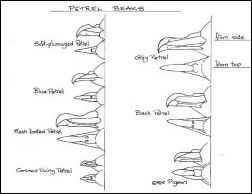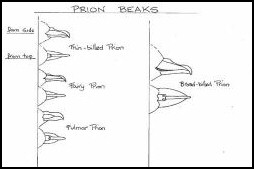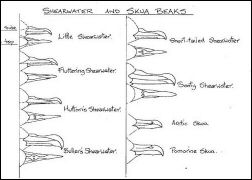

Down by the sea there are golden sands and rainbow shells, and sometimes I see sailing ships, distant on the wavy swells. Shags spread out their shiny wings as the sun glows in the sky, shining its warmth on a wakening skink while swallows hunt for insects as they fly.(from K is for KIWI, Reed)
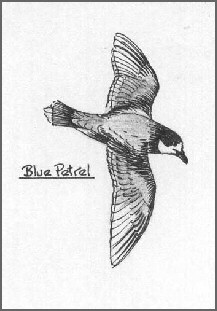
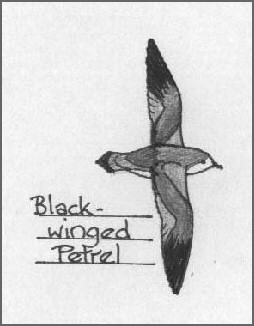
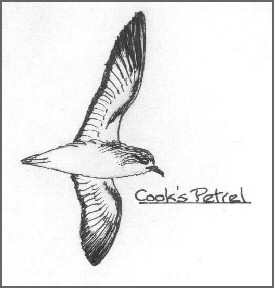
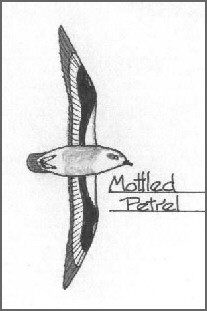
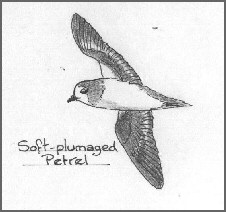
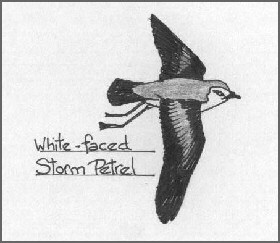
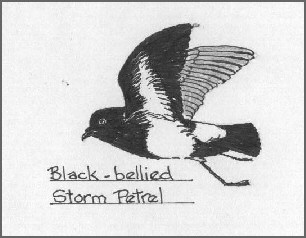
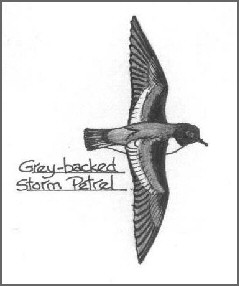
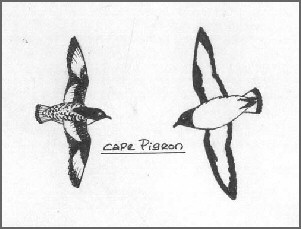
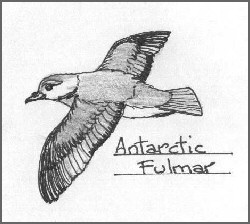
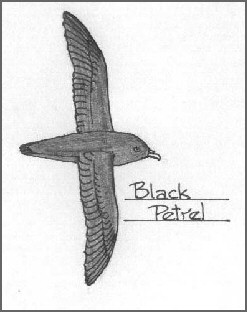
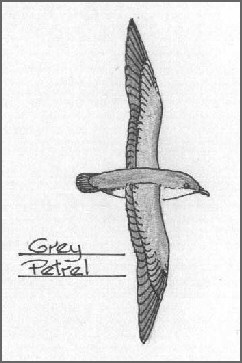
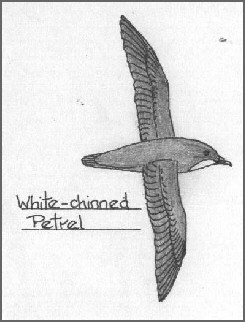
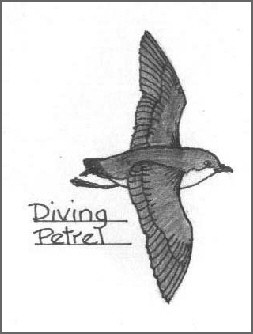
ON THIS PAGE YOU WILL FIND: GADFLY PETRELS; STORM PETRELS; GIANT PETRELS; FULMARINE PETRELS; PROCELLARIA PETRELS AND DIVING PETRELS.
Below you will find pages of SEA BIRD BEAKS to print out and colour.
GADFLY PETRELS
BLUE PETREL Halobaena caerulea
This is a small, prion-like bird, about 30cms long. They are greyish-blue above with white-tipped tail, dark cap and dark 'M' pattern on the upperwings. The bill is bluish-black and the legs and feet are blue with flesh-coloured webs. Blue Petrels breed on circumpolar subantarctic islands and strays to NZ in Winter. Wrecks of these birds appear on mainland NZ beaches in large numbers.

BLACK-WINGED PETREL
Pterodroma nigripennis
Same size as the Blue Petrel, with dark upperparts and mottled forehead and a dark patch below the eye. There is a dark 'M' pattern across the upperwings while the underwings and underparts are white with a bold black marking extending in towards the body from the bend of the wing. These birds breed on the Kermadec and Three Kings Islands, East Island [off East Cape], Portland Island [off Mahia Peninsula] and on the Chatham Islands. In Winter they migrate to the North Pacific. It has been slowly expanding its range and has been observed prospecting breeding sights on some mainland headlands in the far north of Northland, as well as colonising additional islands in the south-west Pacific.

CHATHAM ISLAND TAIKO
Pterodroma magentae
This is a medium sized petrel, about 38cms long. Endemic and very rare. These birds were presumed extinct until rediscovered on the Chatham Islands in 1979. They are sooty grey above with a dark head. Underparts are white and underwings and throat sooty grey. The bill is stout and black and the legs and feet pink with dark outer toes and webs. They are known to breed only on the main Chatham Island. Presumed to migrate to tropical Pacific in Winter. These birds are now the centre of an intensive conservation scheme.

COOK'S PETREL / Titi Pterodroma cookii
Endemic and not common. Slightly smaller than the Blue Petrel, 29cms long, this bird has pale-grey upperparts, white underparts and white underwings, with a narrow black line extending in towards the body from the bend of the wing. There is a dark 'M' pattern across the upperwings. The tail is tipped dark and the bill is thin and black. Feet are mauve with black webs and outer toes. Breeding is on Little Barrier Island in the north and Codfish Island in the south. They bred formerly on mainland NZ.

GREY-FACED PETREL / Oi
Pterodroma macroptera
This is a common native. Large, 41cms long, and nearly all blackish-brown bar the face, which is grey. The bill is short, stout and black and the legs and feet are also black. They have long narrow wings and fly with sweeping arcs and much soaring. They breed on many islands around the northern North Island, and also on some mainland headlands. Breeding occurs in Winter and they are the main Muttonbird harvested by northern Maori, with the young birds being taken in November.

MOTTLED PETREL / Korure
Pterodroma inexpectata
A medium sized petrel, 34cms. Endemic and locally common. They are mottled grey above with a broad 'M' pattern across the upperwings. The underparts are white with a large grey patch on the belly and a bold, black, crescent-shaped mark, extending inwards from the bend in the underwing. Bill and legs are black and the feet are pink with black toes. These birds used to breed on the Nth and Sth Islands, but were wiped out by deforestation and predators. They now breed on islands around Fiordland and Stewart Island and Snares Island, migrating to the North Pacific in Winter.

SOFT-PLUMAGED PETREL
Pterodroma mollis
A medium sized petrel, 34cms. An uncommon native. Bill and legs are black and the feet pink with dark tips to the toes. Ashy-grey upperparts and darker upperwings. The underparts are white with a grey band across the chest, the underwings dark. These birds were once rare but are now appearing in NZ mainland waters in increasing numbers. They breed on the Antipodes Islands, also on sub-antarctic Atlantic and Indian Ocean.

PYCROFT'S PETREL Pterodroma pycrofti
This is a small petrel, 28cms, with pale grey upperparts. Endemic and rare. The underparts are white and the underwings white with a narrow black line extending in towards the body from the bend in the wing. There is a dark 'M' pattern across the upperwings. The bill is thin and black and the feet mauve with black webs and outer toes. They breed on the Poor Knights, Mercury Islands and the Hen and Chickens Group, and migrate to the North Pacific in Winter.

CHATHAM PETREL / Ranguru
Pterodroma axillaris
A small petrel, 30cms. Endemic and very rare. Grey upperparts and neck with a dark mark below the eye. Dark 'M' pattern on upperwings. The underparts are white with a broad black band extending from the bend of the wing to the body. These birds breed only on Rangitira (South-East) Island in the Chathams and the total breeding population is limited to around 100 pairs. They may migrate to the North Pacific in Winter. Broad-billed Prions compete for nesting burrows, and may kill adults and chicks.

STORM PETRELS
WHITE-FACED STORM PETREL / Takahi-kore-moana Pelagodroma marina
This little storm petrel, 20cms, is a common native. The upperparts are greyish-brown with a paler rump and almost black primary wing feathers. The face and eyebrow is white, the crown grey and eyestripe dark. Underparts white. The tail is dark and slightly forked. Feet with yellow webs. The feet project slightly beyond the tail when in flight. These birds breed in a number of colonies on predator-free islands off the main NZ islands. Also on Kermadec, Auckland and Chatham Islands. Sometimes they can be seen in flocks of up to 20 birds.

BLACK-BELLIED STORM PETREL
Fregetta tropica
Another small Storm Petrel, 20cms, which is a locally common native. Blackish-brown upperparts, white rump, and a variable black stripe down the centre of the belly. The bill and feet are black, and the feet extend beyond the square edged tail when the bird is in flight. In the NZ region these birds breed on Auckland and Antipodes Islands. They sometimes follow vessels, and migrate to tropical South Pacific in Winter.
GREY-BACKED STORM PETREL / Reoreo Oceanites nereis
A very small storm petrel, 18cms, and a locally common native. The upperwings are dark, with a pale-grey rump and square, dark-tipped tail. Dark head and throat with white underparts. Usually seen solitary at sea. They breed on the Chatham, Auckland, Antipodes and Campbell Islands, ranging into subtropical seas north of NZ. They nest under tussock and other vegetation and are absent from islands where there are predators.

GIANT PETRELS
SOUTHERN GIANT PETREL / Panguruguru Macronectes giganteus
This is a very large petrel, 90cms, with a thickset body. It is a common visitor. They are greyish-brown, usually with white feathers on the face, crown, throat and chest. The huge horn-coloured bill has a greenish tip and prominent nostril tubes. All-white colour morphs occur. They breed on Antarctic coast and circumpolar subantarctic islands and are a common visitor to NZ coastal waters. These birds will often congregate around fishing vessels and were once common near whaling stations.

NORTHERN GIANT PETREL / Panguruguru Macronectes halli
Also extremely large, 90cms, and a common native. This bird differs from the Southern Giant by having slightly darker plumage and having no 'white morph'. Massive horn-coloured bill with prominent nostril tube and brownish-red tip Breeds at the south of Stewart Island and many subantarctic islands. They are a common Winter visitor to NZ coastal waters, sometimes following vessels into harbour.
FULMARINE PETRELS
CAPE PIGEON / Titore Daption capense
A large petrel, 40cm, with distinctive chequered black and white upperparts and white underparts and underwings. A common native, there are 2 sub-species in NZ. The Snares Cape Pigeon D.c.australe, which has darker upperwings with white patches seperated by black areas. The Southern Cape Pigeon, D.c.capense, which has whiter upperwings with black flecks. The Snares Cape Pigeon breeds on most NZ southern outlying islands while the Southern sub-species breeds on and around the Antarctic coastline. These birds like to follow vessels and are easily seen from the Cook Strait ferries.
ANTARCTIC FULMAR Fulmarus glacialoides
Large petrel, 50cm, with white underparts, bluish-grey upperparts and dark upperwings.There is a white triangle at the base of the primaries which is conspicuous in flight. The bill is flesh coloured and the feet and legs pinkish-grey. A locally common visitor with flocks of over 5000 birds recorded feeding around whaling ships. They breed in the Antarctic region and regularly stray to mainland NZ in the winter.
PROCELLARIA PETRELS
WESTLAND PETREL Procellaria westlandica
A very large, 48cm, blackish-brown petrel. The bill is ivory-yellow with a black tip and the legs and feet black. An uncommon endemic they breed only in the forested coastal hills of Westland. They breed during the winter and the young used to be taken from nesting burrows by Maori and early settlers for food. During the breeding season they can often be seen feeding off the Kaikoura and Westland coasts.
BLACK PETREL / Taiko Procellaria parkinsoni
A large petrel, 48cm, entirely brownish-black with black legs and feet. When in flight the feet extend beyond the tail. A rare endemic, these birds were eradicated by mammalian predators from many of its former mainland colonies. They now breed only on Little and Great Barrier Islands and in winter they migrate to eastern tropical Pacific Ocean They can be seen in the Hauraki Gulf, between Great and Little Barrier Islands and the mainland, the south seas east of Great Barrier and ashore at the breeding colony on Mt. Hobson on Great Barrier Island.
GREY PETREL / Kuia Procellaria cinerea
A large petrel, 48cm, ashy-grey with dark crown and upperparts. The underparts are white and the tail grey and wedge-shaped. The underwings are dark-grey, the bill greenish-yellow and the feet pinkish-grey. They are an uncommon native, once being common on Campbell Island, but eradicated from there by rats and ferel cats. They breed in large numbers on the Antipodes Islands and may range as far north as the Bay of Plenty and the east coast of the North Island.
WHITE- CHINNED PETREL Procellaria aequinoctialis
A very large petrel, 55cm, entirely blackish-brown bar a small white patch on the chin. Sometimes this feature is absent. The bill is pale ivory-yellow and the feet black.As in all Procellarias, the feet project beyond the short rounded tail when in flight. An uncommon native and circumpolar species, breeding on Auckland, Campbell, Antipodes and other sub-antarctic islands.
DIVING PETRELS
COMMON DIVING PETREL / Kuaka Pelecanoides urinactrix
A small. dumpy petrel with short wings and a rapid, direct flight. They are dark above and dusky-white below with a black bill and blue legs and feet. They dive often for food and 'fly' penguin-like in the water. They are an abundant native but vulnerable to rats and cats. Many off-shore island colonies have been eradicated by these predators. They breed on many islands around the North Island, Cook Strait, Foveaux Strait, Stewart Island, Chatham, Snares, Antipodes and Auckland islands.
nbsp;
nbsp;














